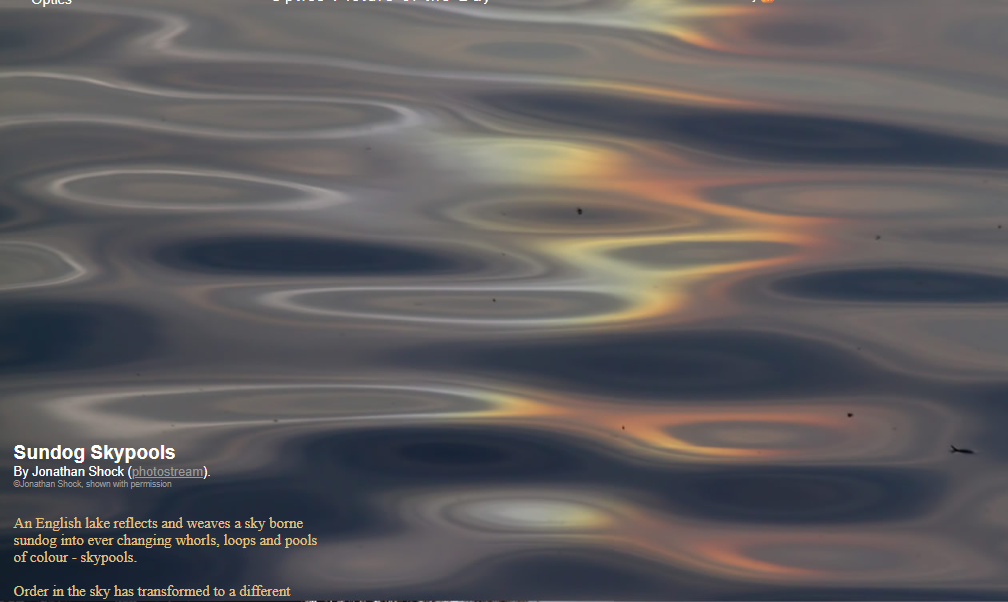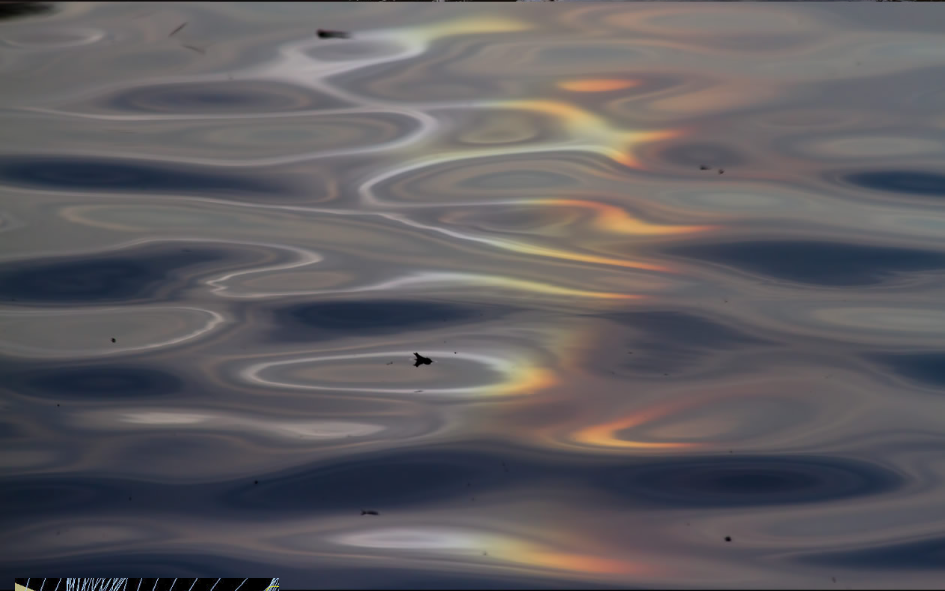OPOD - Sundog Skypools
OPOD - Sundog Skypools: A Mesmerizing Display of Light and Reflection
Have you ever witnessed a breathtaking display of light and color in the sky that seemed almost otherworldly? Sundog skypools, a phenomenon that occurs when an English lake reflects and refracts light into ever-changing patterns of color, is one such spectacle that leaves observers in awe. In this article, we will delve into the captivating world of sundog skypools and explore the science behind this mesmerizing atmospheric optics phenomenon.
The Enigmatic Sundogs and their Icy Origins
Sundogs, also known as parhelia, are atmospheric optical phenomena characterized by bright spots of light appearing on either side of the Sun. These ethereal apparitions are created by hexagonal ice crystals suspended in high and cold clouds. These crystals align themselves horizontally, defying the odds, to create the perfect conditions for sundogs to manifest.
The hexagonal shape of the ice crystals plays a crucial role in the formation of sundogs. As sunlight passes through these crystals, it undergoes refraction, bending the light at specific angles. This refraction causes the light to separate into its component colors, resulting in a beautiful display of vibrant hues. The intricate alignment of the ice crystals ensures that the sundog appears as a concentrated spot of light on either side of the Sun.
The Mysteries of Water's Optical Perfection
While the ice crystals responsible for sundogs possess their own optical perfection, water exhibits its own enigmatic properties. Have you ever wondered why water's surface appears smooth and mirrors light with remarkable precision? Unlike the rough edges of clouds, water's molecular structure allows it to maintain a remarkably flat surface.
Water molecules constantly interact with each other, jostling and attracting one another. To maintain a delicate balance between energy, temperature, and disorder, the surface of water becomes incredibly flat. In fact, it is sculpted to match the curvature of the Earth itself. This smooth surface acts as a near-perfect plane mirror, reflecting light with exceptional accuracy.
The Dance of Wind and Oscillating Waters
However, the English lake where sundog skypools come to life exhibits another order of optical beauty on a larger scale. When wind and confinement at the lake's shores align perfectly, they induce the lake's surface to oscillate in alternating hollows and rises. This oscillation disrupts the perfect mirror-like surface of still water, transforming it into a constantly changing spectacle.
The concavities of the hollows smoothly transition into convex peaks, creating a series of mirrors that resemble concentric ovals. These mesmerizing skypools reflect the elements of the sky and the lake shore in a stunning dance of light and reflection. The scene is not replicated as a simple reflection but rather spun into multiple concentric ovals, capturing the sky and shore in a continuous loop.
The Dynamic Nature of Skypools
One of the most intriguing aspects of sundog skypools is their dynamic nature. These pools and rings of reflection are in constant motion, quickly changing and shifting. Even when captured by cameras, their continuous transformation from place to place can be observed. The fluidity of skypools often leads to their elusive nature, appearing only in small patches and requiring careful observation to be fully appreciated.
To truly treasure the beauty of sundog skypools, one must allow time to flow freely and witness the ever-changing dance of light and reflection. Each moment brings a new configuration of pools and rings, captivating those fortunate enough to witness this captivating atmospheric phenomenon.
Conclusion
Sundog skypools offer us a glimpse into the captivating world of atmospheric optics. The intricate alignment of ice crystals and the oscillating waters of an English lake combine to create a mesmerizing display of light and reflection. These ethereal phenomena remind us of the wonders of our natural world and the harmonious interplay of light and matter. So, next time you find yourself gazing at the sky, keep an eye out for the elusive sundog skypools, and allow yourself to be transported into a realm of enchantment and beauty.

Sundog Skypools
By Jonathan Shock (photostream).
©Jonathan Shock, shown with permission
An English lake reflects and weaves a sky borne sundog into ever changing whorls, loops and pools of colour - skypools.
Order in the sky has transformed to a different
order of an aquatic kind.
In high and cold clouds, hexagonal ice crystals improbably aligned to float near horizontal and of uncanny geometric plus optical perfection make sundogs possible.
Water has its own optical perfection and order, microscopically it is far beyond that of the sundog's crystals. How often do we wonder why water's surface is smooth and when vibration free mirrors light more precisely than the best crafted optics? Why is it not rough or wrinkled or fuzzy like cloud edges? Water's molecules jostle and attract. To keep a thermodynamic balance between energy, temperature and disorder its surface is forced incredibly flat - or more precisely, sculpted to Earth's curve - until, that is, temperature and disorder abruptly win over energy and it boils.
The English lake water has another order on a larger scale. Wind and perhaps confinement at its shores can, when just so, induce its surface to oscillate in alternating hollows and rises. Still water's perfect plane mirror is replaced by one that, even when time frozen by cameras, has curvature changing continuously from place to place. Concavities of hollows grade smoothly to convex peaks. These mirrors are the stuff of skypools. There is no simple single reflective replication of the scene. Instead, each element of sky and lake shore gets spun into multiple concentric ovals, sky then shore then sky and shore again.. ..and again.
Set time free and the pools and rings quickly change and move, so quickly that they can escape notice. And often they show only in small patches. Like so many of the best optical sights, they must be sought to be treasured.


Note: this article has been automatically converted from the old site and may not appear as intended. You can find the original article here.
Reference Atmospheric Optics
If you use any of the definitions, information, or data presented on Atmospheric Optics, please copy the link or reference below to properly credit us as the reference source. Thank you!
-
<a href="https://atoptics.co.uk/blog/opod-sundog-skypools/">OPOD - Sundog Skypools</a>
-
"OPOD - Sundog Skypools". Atmospheric Optics. Accessed on November 26, 2024. https://atoptics.co.uk/blog/opod-sundog-skypools/.
-
"OPOD - Sundog Skypools". Atmospheric Optics, https://atoptics.co.uk/blog/opod-sundog-skypools/. Accessed 26 November, 2024
-
OPOD - Sundog Skypools. Atmospheric Optics. Retrieved from https://atoptics.co.uk/blog/opod-sundog-skypools/.